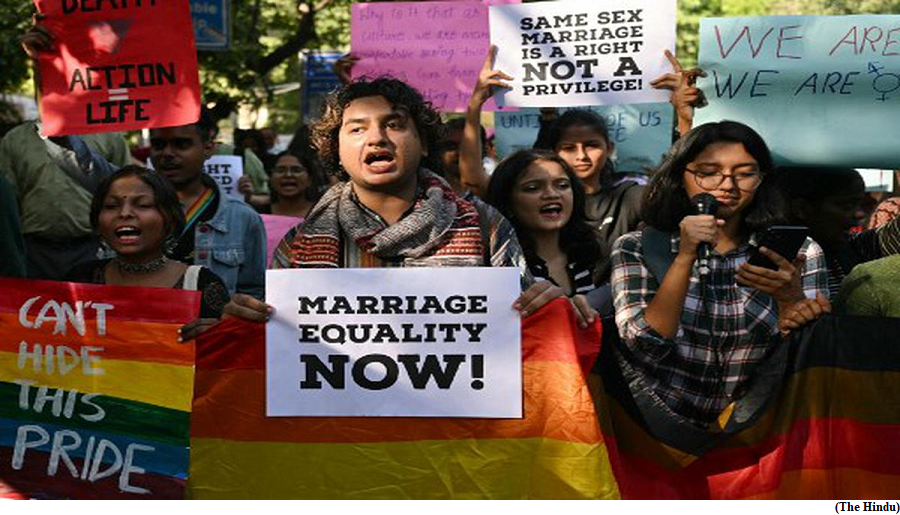Why did SC not allow same-sex marriage? (GS Paper 2, Social Justice)

Why in news?
- Recently, a five-judge Constitution Bench of the Supreme Court, declined to legalise same-sex marriage, leaving it to Parliament to legislate on the subject.
- The Bench ruled that there is no fundamental right to marry, and the court cannot intervene.
- Though all five judges accepted that it was time to end discrimination against same-sex couples, they failed to reach a consensus on giving queer couples the status of a legally recognised “civil union,” with a majority of three judges holding that any legal status to such a union can only be through enacted law.
What did the petitioners want?
- The petitioners had sought a ruling by which the Special Marriage Act (SMA), 1954, which provides for a civil marriage for couples who cannot marry under their personal law, should be interpreted as gender-neutral, thus allowing same-sex couples to marry under it.
- The SMA, they argued violated Articles 14, 15, 19, 21 and 25 by not allowing marriage between same-sex, gender non-conforming, LBGTQIA+ couples, and sought the words “husband” and “wife” as well as any other gender-specific term to be substituted by the word “party” or “spouse”.
- They also sought joint adoption rights, nominee rights with respect to healthcare decisions, “preventative, remedial, protective and punitive measures” by all State governments to guarantee their safety and security, and directions to the Union and State governments, district and police authorities to provide protection to adult, consenting LGBTQIA+ couples from their families.
How did the top Court rule?
- The Supreme Court said it could not issue a mandamus to Parliament; it determined the scope and effect of certain fundamental rights, and then ruled that the Constitution does not recognise marriage as a fundamental right.
- The Constitution does not expressly recognise a fundamental right to marry. An institution cannot be elevated to the realm of a fundamental right based on the content accorded to it by law. However, several facets of the marital relationship are reflections of constitutional values including the right to human dignity and the right to life and personal liberty.
- The majority opinion, of Justices Ravindra Bhat, Hima Kohli, and backed by a separate concurring judgment by P.S. Narasimha, said that “an entitlement to legal recognition of the right to union, akin to marriage or civil union, or conferring legal status upon the parties to the relationship can be only through enacted law.”
- The minority opinion, of Chief Justice of India D.Y. Chandrachud and Justice Sanjay Kishan Kaul, said the LGBTQIA+ community had a fundamental right to form relationships and that the state was obligated to recognise and grant legal status to such unions, so that same-sex couples could avail the material benefits provided under the law.
- Queerness is a natural phenomenon, which the Navtej Singh Johar case had clarified. The judgment in NALSA also explored the presence of the transgender identity and other forms of queerness.
- The Court said the consequence of the judgments on NALSA and Navtej Johar is that the members of the queer community are no longer second-class citizens. But having said that, it stopped short of legalising same-sex marriage.
Why did SC refuse to read down the SMA?
- The Court felt that if the SMA was held void for excluding same-sex couples, it would mean going back to a time when two persons of different castes and religions could not marry.
- It said that if it were to read down provisions of the SMA, meaning add or delete words, this would be venturing into the realm of the legislature.
Will the legislature be open to the idea?
- Throughout the hearings, the government held that it was against same-sex marriage. It had also pointed out that judicial intervention would cause “complete havoc with the delicate balance of personal laws.”
- Activists and rights lawyers are not convinced whether the judiciary lobbing the issue back to the legislature will lead to any change.
- The Court has said the state must take “remedial action” because if it regulates marriage only for heterosexual couples, it “adversely impacts” the LGBTQIA+ community, resulting in their exclusion, and “denial of entitlements/benefits,” and that “this injustice and inequity results in discrimination.”
- It has set down a set of guidelines, from setting up a committee chaired by the Cabinet Secretary for the purpose of defining the scope of entitlements of queer couples who are in unions, to directing police stations to not harass the community.
- The Court said the state may choose from a number of policy outcomes: they may make all marriage and family related laws gender-neutral, or they may create a separate SMA-like statute in gender-neutral terms.
- They may pass an Act creating civil unions, or a domestic partnership legislation, among many other alternatives.
How many countries have legalised marriage equality?
- According to the Human Rights Campaign, a US-based LGBTQ advocacy group, only 32 countries worldwide recognise same sex marriage.
- These include the United States, Canada, Australia, Argentina, South Africa and Taiwan. In 2019, Taiwan became the first Asian country to recognise same sex marriage. The legislation for it was brought in following a court ruling in 2017
- In most countries that do so, marriage equality was introduced by legislation. It was recognised through a court ruling in only 10 countries.


